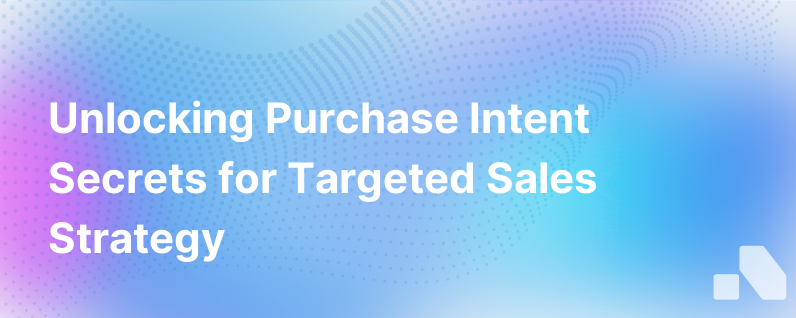Purchase Intent
Published on November 21, 2023 by Sawyer Middeleer
In the ever-evolving terrain of B2B sales and marketing, the concept of purchase intent has emerged as a guiding star for organizations looking to drive their sales strategy with precision and foresight. Comprehending purchase intent equips businesses with the predictive power to proactively engage potential buyers, allocate resources efficiently, and ultimately, convert prospects to loyal customers.
Decoding Purchase Intent
At its core, purchase intent is an indicator of a prospect’s likelihood to buy. It relies on a myriad of signals that suggest a prospective buyer is in the market for a product or service. These signals can be explicit, such as a direct inquiry about product pricing, or implicit, like a series of actions indicating interest, including website visits, downloaded content, or engagement with specific marketing materials.
Crucially, purchase intent isn’t a stagnant metric; it's dynamic and subject to continuous change as prospects continue their buyer's journey. It's closely tied to where they stand within the sales funnel—whether they're just getting to know your product or seriously evaluating it against competitors.
Why Purchase Intent Matters
In today's saturated markets, it's not enough to have a great product—you also need to ensure you're talking to the right people at the right time. That’s where purchase intent comes in. With an understanding of intent, sales reps can prioritize leads more effectively, meaning they spend less time on those less likely to convert and focus their energy on those who are poised to make a purchase.
Moreover, purchase intent data empowers marketing teams to create targeted campaigns that strike a chord with high-intent prospects, thereby increasing conversion rates and maximizing ROI on marketing spend.
Gathering Purchase Intent Data
The pursuit of purchase intent begins with identifying and collecting the right data. This typically involves a strategic blend of first-party data sourced directly from your digital properties and third-party data acquired from partner platforms or intent monitoring services. Here's how you can compile a comprehensive picture of prospective buyers’ purchase intent:
-
First-Party Behavioral Data: Track website analytics to see which pages prospects visit, what content they download, and how frequently they engage with your site. Look at email opens, clicks, and responses for further insights into their interests.
-
CRM and Sales Data: Scour your CRM for historical purchase data, ongoing opportunities, and past interactions. This can help identify patterns and predict future behaviors.
-
Social Media Monitoring: Utilize listening tools to pick up cues from social media—mentions, hashtags, and discussions can reveal where a prospect is in the buyer's journey and how they perceive your brand.
-
B2B Data Partnerships: Partnerships with data providers can give you access to a broader range of intent signals from across the web, like content interactions outside your own channels.
-
Content Engagement: The types of content prospects engage with can tell you a lot about their purchase intent. For instance, a prospect reading general industry insights might be further up in the funnel than one comparing specific features or pricing options.
Leveraging AI for Deeper Insights
Predictive analytics and machine learning algorithms have significantly enhanced the way businesses interpret and act upon purchase intent data. These AI-driven tools can analyze vast datasets, recognize subtle patterns, and forecast purchasing behaviors with a high degree of accuracy. AI platforms process quantitative and qualitative data to deliver actionable insights right when you need them. This kind of intelligence can place you steps ahead of the competition, ensuring your engagement strategies are informed by data-driven foresight rather than retrospective guesswork.
Operationalizing Purchase Intent
Understanding purchase intent data is only part of the equation. The real challenge lies in integrating these insights into your sales and marketing operations. Here are concrete steps your team can take:
-
Lead Scoring: Implement automated lead scoring systems that rank prospects based on their purchase intent signals. This can help sales teams prioritize their outreach and ensure high-intent leads are contacted swiftly.
-
Personalization at Scale: Use intent data to tailor your communications. For instance, someone who has viewed a product demo might be more receptive to a specialized follow-up email or a personalized offer.
-
Dynamic Campaigns: Adjust your marketing campaigns dynamically based on prevalence of high-intent signals. Engage prospects with a sequence of nurturing tactics designed to meet them at each stage of their journey.
-
Sales Enablement: Equip your salespeople with insights into a prospect's purchase intent—giving them conversation starters and negotiation leverage points tailored to the lead’s specific interests and behaviors.
A Note on Timing
Timing is not just a variable in this equation; it is possibly the critical factor. Engaging too soon or too late with a prospect can both lead to lost opportunities. Purchase intent data provides a temporal dimension to your strategy, allowing for interactions to be timed to meet the rhythm of the prospect's decision-making process.
The Future of Purchase Intent Data Utilization
As technology continues to evolve, the ability to predict and influence purchase intent will likely become even more nuanced. We can expect more sophisticated analysis techniques and even closer integration between sales and marketing operations. This heightened cohesiveness and shared intelligence will allow businesses to engage with prospects more relevantly and efficiently than ever before.
In summary, purchase intent is a powerful concept with the potential to revolutionize how B2B entities attract and retain customers. By incorporating advanced data analytics, personalizing engagement, and responding in real-time to the evolving needs of prospects, businesses can achieve a competitive edge in converting prospects into not just customers—but advocates and partners in success.